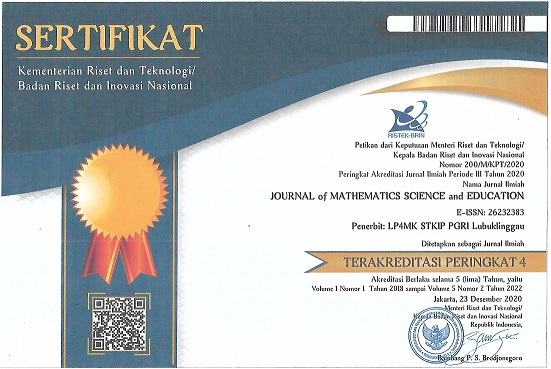INSTRUCTIONAL DESIGN LINES AND ANGLES WITH THE CONTEXT OF A RAILING REED IN CLASS VII
Abstract
The iemed of this study was to produce learning trajectories in helping students in learning lines and angles in the context of bamboo fences. The method used in this study was design research type validation studies by testing 6 students before involving 34 studentsof class VII MTs Negeri Jambat balo Pagaralam with by using Hypothetical Learning trajectory (HLT). Then the HLT was developed and a set of activities is applied to obtain a better understanding about how to develop the students understanding of line and angle material through three stages, namely preliminary design, the design experiment, and retrospective analysis. The research conducted produced learning trajectory which consisted of a series of learning processes in three activities, namely making bamboo fence, problem solving line material, and problem solving in angle material. The result of the research showed by using the bamboo fence context students understood the concepts in line and angle learning and students can solve problems related to the material lines dan angles in everyday life.
References
Biber, C., Tuna, A., dan Korkmaz, S. (2013). The mistake and the misconceptions of the eighth grade students on the subject of angles. European Journal of Science and Mathematics Education, 1(2): 50 – 59.
Depdiknas. (2008). Materi KTSP. Jakarta: Pusat Bahasa.
Deshinta, Argaswari, dan Usodo, B. (2015). Analisis Kesulitan Belajar Geometri Kelas VII SMP Pokok Bahasan Sifat Sudut yang Terbentuk dari Dua Garis sejajar yang Berpotongan dengan Garis Lain. Prosiding Seminar Matematika dan Pendidikan Matematika UNY, 413 – 422.
Gravemeijer, K. dan Cobb, P. (2006). Design Research From A Learning Design Perspective. Dalam Akker, dkk. (Ed.): Educational Design Research. New York: Routledge. Hlm. 17 – 51.
Nieveen, N., McKenney, S, dan Akker. (2006). Educational Design Research: The Value of Variety. Dalam Akker, dkk. (Ed.): Educational Design Research. New York: Routledge. Hlm. 151 – 158.
Rohati. (2015). Pengembangan Perangkat Pembelajaran Berbasis Pendekatan Realistic Mathematics Education (RME) pada Materi Volume Bangun Ruang Sisi Datar yang Mendukung Kemampuan Komunikasi Siswa di SMP. Edumatica, 5(2).
Sunismi. (2015). Pengembangan Bahan Ajar Geometri dan Pengukuran Berbasis Realistic Mathematics Education (RME) untuk siswa SMP Kelas VIII. Jurnal Pendidikan Matematika, 1(1): 1 – 14.
Suryana, M.F. (2015). Optimalisasi Penguasaan Materi Garis dan Sudut Melalui Pendekatan Pembelajaran Berbasis Masalah. Jurnal Manajemen Pendidikan, 10(2): 141 – 153).
Yuwono, M.R. (2016). Analisis Kesulitan Belajar Siswa Kelas VII SMP dalam Menyelesaikan Soal Materi Segitiga dan Alternatif Pemecahannya. Magistra, (95): 14 – 25.

This work is licensed under a Creative Commons Attribution 4.0 International License.

This work by Journal of Mathematics Science and Education is licensed under a Creative Commons Attribution-NonCommercial-ShareAlike 4.0 International License.



















